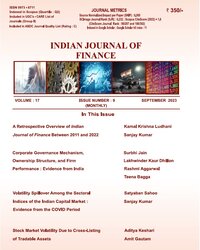Modelling Volatility Clustering and Asymmetry : A Study of Indian Index Futures Markets
Subscribe/Renew Journal
The main objective of this paper was to study volatility clustering and asymmetrical features of the Indian index futures markets using the most commonly used symmetrical and asymmetrical generalized autoregressive conditional heteroskedasticity models such as traditional GARCH and threshold GARCH (TGARCH), respectively. To achieve the objectives of the study, NIFTY futures index - FUTIDX and MCX futures index - MCXCOMDEX was used as a proxy to the Indian stock and commodity futures market, respectively. The daily data for selected indices were collected for a period of 12 years from May 13, 2006 to June 13, 2018 from the official websites of the respective exchanges. The results of the study indicated that though conditional volatility was present in both of the selected futures markets, but threshold effect as well as leverage effect was present in the Indian stock futures market only. Therefore, we concluded that negative and positive news did not have a symmetrical impact on the volatility of stock futures market returns, and moreover, bad news created more volatility in the Indian stock futures market as compared to good news.
Keywords
Asymmetric Volatility, Garch, Tgarch, Commodity Futures (mcxcomdex), Stock Futures (futidx), Leverage Effects
C58, G1, G13
Paper Submission Date : July 18, 2018 , Paper Sent Back For Revision : February 7, 2019 , Paper Acceptance Date : February 18, 2019
User
Subscription
Login to verify subscription
Font Size
Information

Abstract Views: 227

PDF Views: 0


